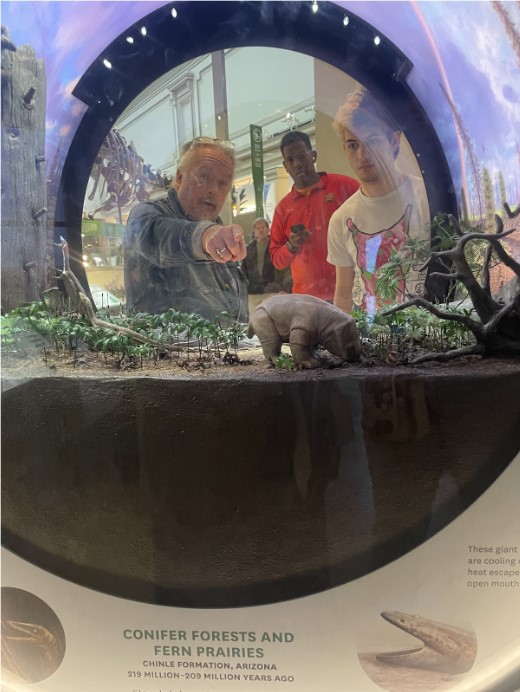
Exhibit 1: Unseen Connections
This exhibit was focused on the effects of cellphones in the modern world. There were large interactive "phone-like" displays that demonstrate modern features, a disassembled and displayed phone, and the periodic table of phone elements. These three features were good at explaining the entire production cycle of phones, and when combined, effectively explain the exhibit. The element section of the exhibit has personal stories of the impacts that mining for the elements has on both the people and the environment, being very destructive. Alongside the phones themselves, it also discusses the societal impact of phones, how misinformation can spread quicker around the world, and how people can become more withdrawn due to the ever-present internet connection of phones.
Exhibit 2: The David H. Koch Hall of Human Origins
The hall of human origins is mostly dedicated to human evolution, but there is a decent section detailing current human behaviors. There were three main topics discussed in this section. Firstly, human evolution was displayed, which was influenced by the human desire to discover history. Secondly, we created a "World of symbols". Humans' ability to communicate through non-direct means has greatly helped humans preserve history and develop society and systems of interaction. The disigners focused on a progressive evolution of symbols alongside the evolution of humans. The last topic is the modern population, and its impact on the world. This section is in its own closed off hall, which highlights how far we've been separated from our ancestors. One of the issues with this hall, is that it doesn't press the issue of anthropogenic change enough. It lists that by 1995, we had affected 83% of the world's land, which is sizable, but that data is highly outdated. For a topic that changes every year, the hall should be larger and more detailed.


Exhibit 3: The Sant Ocean Hall
This next exhibit is about aquatic impacts of human activity. We watched two videos in this section. Firstly was "Cause a Sea Change: Save Sharks" It explains that shark overfishing is leading to significant population declines worldwide. While many countries lack effective measures to control shark overfishing, the United States has implemented strategies through the National Oceanic and Atmospheric Administration (NOAA). The video presented is fairly simple and provides information primarily through infographics, making the content accessible and easy to understand. Second, a video titled "Deep Sea Ocean Creatures". Overall, the information in the video presented wasn't extremely useful, rather just being insperational. The video delves into a variety of ocean creatures, including species like Henretia, Caulophaci, and other fascinating deep-sea animals. It showcases many rare and lesser-known creatures that are challenging to study and understand. There was also a spherical display to showcase ocean patterns. Ocean currents such as the gulf stream are highlighted and arrows display its full path. This format allows viewers to see a proportional movement of ocean currents much better than a flat screen. Overall, this section had the least amount of information related to anthropogenic change.
Exhibit 4: The Koch Hall of Fossils
This exhibit has dioramas that show possible biomes in various environments. Shown above is a floodplain 66 MYA, which had abundant life in and out of the water. To the side is a conifer forest 209 MYA, which also supported various life, grasses, and aquatic animals. The cool thing about these dioramas is that they also show subterranian life and sediment buildup. Lastly, against some side panels is info on CO2 levels over time. The earth was frequently much hotter than it currently is due to higher CO2 levels. However, the exact data for the CO2 levels is not explained. The general events are: plants spreading causing a drop in CO2 at 360 MYA, and volcanic activity causing higher CO2 at 260 MYA. For the section that describes the present, data on the average temperature of the earth is presented to show that there is rapid warming occurring. The data about the future is sparse, but data about potential sea level rise is provided. This exhibit shows that there could be 1-4 feet of sea level rise by 2100.